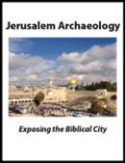
Excavate the Holy Land: Students and volunteers excavating Timna. Courtesy Central Timna Valley project.
Every year, scores of excavations take place around the Holy Land, many of which rely in large part on volunteers just like you! While reading news about marvelous finds from Hippos-Sussita or El-Araj, it is hard to imagine that many of these discoveries are made with the help of students and volunteers. In what other field can a complete beginner have such a profound impact? Because of this, and because of our passion for biblical archaeology, the Biblical Archaeology Society (BAS) has been connecting volunteers with opportunities to participate in some of the most exciting archaeological excavations around the Holy Land for nearly 50 years.

Excavate the Holy Land
For 2023, the Biblical Archaeology Society is featuring nearly two dozen incredible excavations from Israel, Jordan, and Turkey on our Digs Page. This will be our 47th year compiling one of the most comprehensive lists of dig opportunities in the Holy Land. It is also the 30th anniversary of the BAS Dig Scholarships, which through the years has provided more than 300 scholarships to volunteers, students, young scholars, and enthusiasts.
So with all of these incredible opportunities to get involved in archaeology, let us dig into two specific sites looking for volunteers early in 2023: Timna and Tiberias. While both begin with a “T,” that is about where the similarities end between two sites that are located more than 200 miles apart.
Timna and Tiberias
Let us start in the south with Timna (excavating from January 22 to February 4, 2023). This site, located in Israel’s southern Arava Desert, was for thousands of years one of the most important sources of copper in the ancient Near East. While utilized since the Chalcolithic period (c. 4500–3300 BCE), the Timna mines reached the peak of their production during the Late Bronze Age (c. 1550–1200 BCE) and Early Iron Age (c. 1200–1000 BCE), when they were controlled first by the Egyptians and later by the upstart Edomite kingdom. Indeed, the control of this site and the economically important copper trade may have been a driving factor behind Shoshenq’s (biblical Shishak’s) campaign to the southern Levant as described in the Bible (1 Kings 14:25–26; 2 Chronicles 12:1–12) and his famous Bubastite Portal inscription from Karnak. Similarly, control of this copper trade may likewise have been the reason behind Judah’s early attempt to control Edom, as possibly reflected in the Mesha Stele.
This year, volunteers at Timna are invited to “unearth metallurgical installations, investigate mines and miners’ camps, and glean insights into the Bronze and Iron Age metalworkers at Timna.” Moreover, volunteers will immerse themselves in the breathtaking desert landscape as they pitch their own camp within Timna National Park and get a taste of the life lived by the same nomads that inhabited the site some 3,000 years ago.
Take the highway four and a half hours north and you will find yourself not only in a new world but at the archaeological site of Tiberias (excavating in February and March 2023). Nestled on the shores of the spectacular Sea of Galilee, Tiberias was founded in 19 CE and, over the centuries, became a bastion of Jewish life and learning, a pilgrimage destination for Christians, and the capital of the Arabic district of Jund al-Urdunn. Tiberias was founded by Herod Antipas, the son of Herod the Great, who named the new city for the Roman emperor Tiberius, who succeeded Augustus in 14 CE. While the New Testament does not mention Jesus visiting Tiberias, its location just a few miles south of Capernaum, where Jesus frequented, makes it likely that he would have stopped in the city at various points. Later, in the third and fourth centuries, Tiberias would be the site of the compilation and completion of the Jerusalem Talmud. This summer, volunteers can take part in excavating Tiberias’s Byzantine church and the city’s ancient cardo.
From south to north, desert to sea, Bronze Age to Byzantine, the Holy Land is filled with dig sites looking for volunteers to help them excavate history. So, whether you are interested in the worlds of Kings David and Solomon, want to walk in the footsteps of Jesus and the apostles, or work in an ancient Phoenician city, there is an archaeological dig for you.
Related reading in Bible History Daily:
Not a BAS Library or All-Access Member yet? Join today.
The post Excavate the Holy Land from South to North appeared first on Biblical Archaeology Society.





0 Commentaires